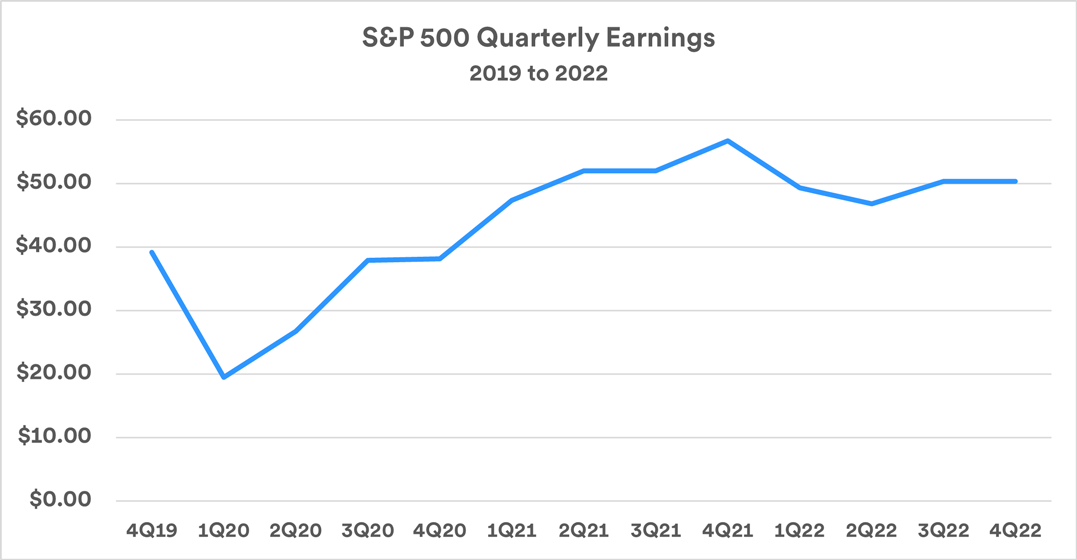“Lower earnings projections reflect the likelihood of slower economic growth and an inability of companies to pass on the full extent of cost increases to their customers,” says Haworth. “Another potential issue is the higher cost of borrowing given today’s elevated interest rates.” He is watching if many companies need to refinance existing debt at today’s higher rates, which could further dampen earnings expectations.
However, Haworth also notes that if a recession is avoided, it may mean that earnings expectations were too pessimistic, and favorable earnings surprises could result. Often when that occurs, the stock market reacts positively. Nevertheless, Haworth anticipates the environment will remain challenging. “Unless the inflation rate falls more significantly, it’s difficult to forecast substantial earnings improvement.”

Source: S&P Dow Jones Indices, “S&P 500 Earnings and Estimate Report,” April 6, 2023.
The role of earnings in stock valuation
The publicly traded companies represented as stock holdings in your portfolio deliver quarterly financial statements that include a wide range of information. This includes a breakdown of sales (revenue) and expenses, the two key factors that determine earnings. Earnings represent a company’s after-tax net income, or profits.
Earnings information is important because it provides a glimpse into the company’s business success in recent months. In many cases, companies provide “guidance” regarding their future earnings and growth prospects. This guidance serves as a preview of what may come based on trends companies experience in their businesses. While corporations often provide earnings guidance, it’s not a requirement. According to FactSet, as of May 12, 2023, 50 S&P 500 companies provided “negative” second quarter 2023 earnings guidance, a signal to investors that earnings for the quarter may be less than initially expected. By contrast, 37 companies provided “positive” guidance, indicating they anticipate better-than-expected quarterly earnings results.1 This only represents projections from companies. More telling will be when actual results become available.
Professional stock analysts often estimate, in advance, their own expectations for what companies will report each quarter. “Investors are very attuned to the forward-view of earnings, which reflects the stock market as a discounting mechanism,” says Haworth. In other words, stock prices are based less on a company’s past performance and more on expectations of future financial success. “Stock prices typically incorporate a consensus market belief about the future state of a company, including earnings, growth prospects, risks, pricing challenges and other factors,” says Haworth.
How to value a company’s stock
Earnings provide the basis of one of the major measures of a stock’s individual value. Investors often use a statistic known as the Price-to-Earnings (P/E) ratio to help assess how expensive a stock is relative to the rest of the market. In other words, it is the ratio of the current price of a stock compared to the company’s earnings. If a stock is trading at $30 per share and the company’s annual earnings are $2/share, the P/E ratio is 15.
P/E ratios are often expressed in two ways, trailing and forward. Trailing P/E reflects how the current stock price measures up against earnings over the previous 12 months. For example, in mid-May 2023, the P/E ratio for one of largest stocks in the U.S. market, Microsoft Corporation (MSFT)., was 33.36. That reflected its current share price in relation to earnings generated over the previous 12 months. A second way to assess valuation is by looking at P/E ratios reflecting anticipated (forward) earnings over the next 12 months. On that basis, the P/E ratio for Microsoft stock is slightly lower, at 28.33.2 P/E ratios are generally expected to be lower when based on forward earnings rather than on trailing earnings, as companies typically are expected to be increasingly profitable over time.
Haworth notes that P/E ratio is just one measure of a stock’s performance. “We look at a variety of valuation assessments, including sales growth and book value growth, which is essentially a way of estimating the liquidation value of a company.” Other factors would include a company’s cash flow and a stock’s dividend yield.
When trying to assess which of two stocks offer the best investment opportunity based on their P/E ratios, it’s important to recognize that it’s not always an “apples-to-apples” comparison. “There can be variations in the expectations for different kinds of stocks,” says Haworth. “Determining fair value has a lot to do with the underlying growth rate of the industry in which the company competes.” Some stocks may be viewed with a longer lens, as investors demonstrate a willingness to bid up prices based not on current earnings, but on expectations of future profitability. “This tends to be the case, for example, with stocks that invest in new technology that may not have an immediate payoff but offer the potential of future strong earnings if they succeed,” says Haworth. “Other stocks may have lower P/E multiples, but those companies generate steadier earnings, so the payoff on the investment needs to happen in a more compressed timeframe.”
Factors affecting corporate earnings
While companies’ financial statements may seem straightforward, variables can be reflected in the earnings they report. It’s important to be able to understand the numbers that are most applicable to a stock’s valuation, and what might not be as pertinent.
“It is worth reading beyond the headline numbers,” says Haworth. “Unique, one-time events may affect earnings, either positively or negatively.” For example, if a company’s earnings declined due to a one-time major expense, that shouldn’t necessarily reflect poorly on its outlook. Similarly, if a company reports a strong boost to earnings, for example, because it sold off one of its business units, that may not reliably indicate future strength.
How earnings are reflected in the broader stock market
Analysts often use earnings estimates to determine whether the broader stock market is fairly valued. For example, annual operating earnings for the S&P 500, an index of approximately 500 large company U.S. stocks, totaled $196.95 per share as of the fourth quarter of 2022.3 The anticipated change in that number going forward can provide investors with a broad sense of the market’s valuation.
As they do with individual stocks, analysts can also place a P/E valuation on the broader market. As of April 30, 2023, the P/E ratio of the S&P 500 based on earnings in the prior 12 months was 22.23, while the P/E ratio based on projected earnings for the next 12 months is 18.62.4 Analysts may set different valuations on the market based on varied sets of projections.
When fundamentals are overshadowed
If earnings are assumed to be the most fundamental measure of a stock’s, or market’s value, there are times when earnings are overshadowed. For example, in 2022, while corporate earnings were generally improving, stocks suffered a significant decline.
“In 2022, three primary factors shifted investor sentiment,” says Haworth. “High inflation, the Federal Reserve significantly raising interest rates and slower economic growth. Investors anticipated that all these factors would have a negative impact on the business environment, and ultimately, on corporate earnings.”
Markets experience such periods when non-market factors, some economic, some triggered by other events such as a geopolitical conflict or a health care crisis like the COVID-19 pandemic, overshadow current fundamentals related to earnings.
Preparing for the current environment
Haworth believes that earnings have returned as a primary focus for investors in 2023. “Now we’re waiting to see what impact the direction of the economy will have on business and consumer spending and how that affects corporate profit margins going forward.” Haworth says in the opening months of 2023, the most favorable earnings reports appear to be centered among a narrow band of S&P 500 sectors. “Technology, communication services and consumer discretionary stocks seem to be performing best in the current economic environment,” according to Haworth. “Ultimately, we want to see broader participation in the market, both in terms of stock price performance and earnings results from individual companies.” Haworth notes if positive earnings results are spread out over more sectors, it could result in a more sustained stock market rally.
As you assess your investment options and how to best position your portfolio, it can be helpful to do so in the context of a financial plan. Talk with your U.S. Bank wealth professional to review whether changes to your investment strategy may be warranted to better reflect your goals, risk appetite and time horizon.





